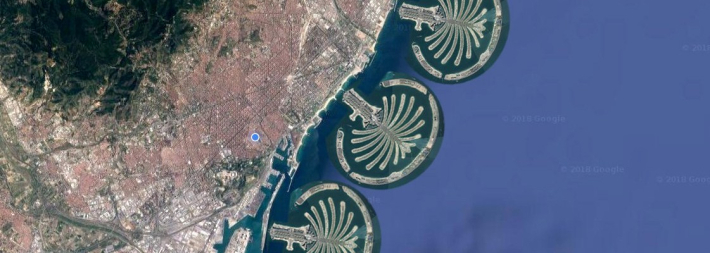Elections for the mayorship of Barcelona are coming up later this year, and we’re already being delivered promises in the form of outrageous urban-architectural proposals. As reported by yesterday’s La Vanguardia, a German businessman named Karl Jacobi, who is running for mayor, is promising to build 300,000 social housing units on a new artificial island off Barcelona’s coast. Yes, three hundred thousand.
In a city that seriously lacks affordable places to live, social housing is a serious necessity. But an artificial island? Has Herr Jakobi considered how large such an island would have to be to accommodate that many dwellings? If this island were to have approximately the same density as the central Eixample district (230 dwelling units / ha according to the Density Atlas), then over 1300 hectares or 13 square kilometres of artificial land would be required. Just to put that number into perspective, Dubai’s artificial archipelago The Palm Jumeirah (home to a luxury housing development by Catalonia’s “Dream and Nature” architects RCR) is just under 6 km2, so more than two Palm archipelagoes would be needed to fulfil this electoral promise.
The amount of land needed to build 300K social housing units on an artificial island off the coast of Barcelona at the same density as the Eixample district.
Although Barcelona has a high urban density and is hemmed in by mountains, leaving few greenfield sites, it actually contains within its city limits a good number of empty, abandoned or under-used lots, along with thousands of empty flats that are a consequence of bank repossessions, evictions, or simply run-down buildings. For the sake of economy, maximizing existing urban infrastructure, and urban continuity, it is clearly better to build on brownfield rather than greenfield sites. An artificial island is merely a costlier and more ecologically disastrous greenfield site.
Then there’s the problem of consolidating so much social housing in one place, creating a ghetto of poverty that would be physically cut off from the rest of the city. I shudder to think whether the real intention behind this New Welfare Island isn’t to “put away the poor”. Social housing is best spread around the city, not concentrated in one place, let alone on an island.
Finally, how much sense do artificial islands make in times of climate change, ever fiercer storms, and rising sea levels?
Funny how the most outrageous and preposterous urban-architectural ideas (eg. Trump’s border wall) have a tendency to come up during election campaigns.
Source: Criticalista

